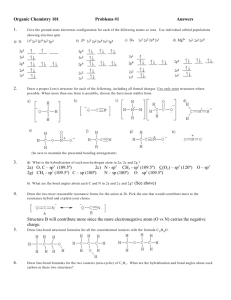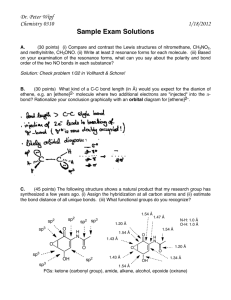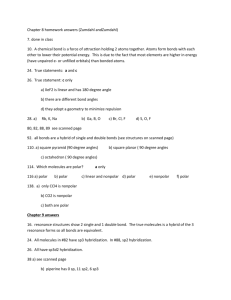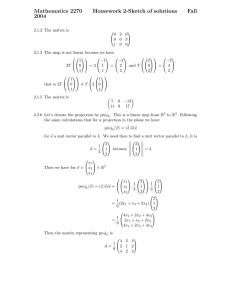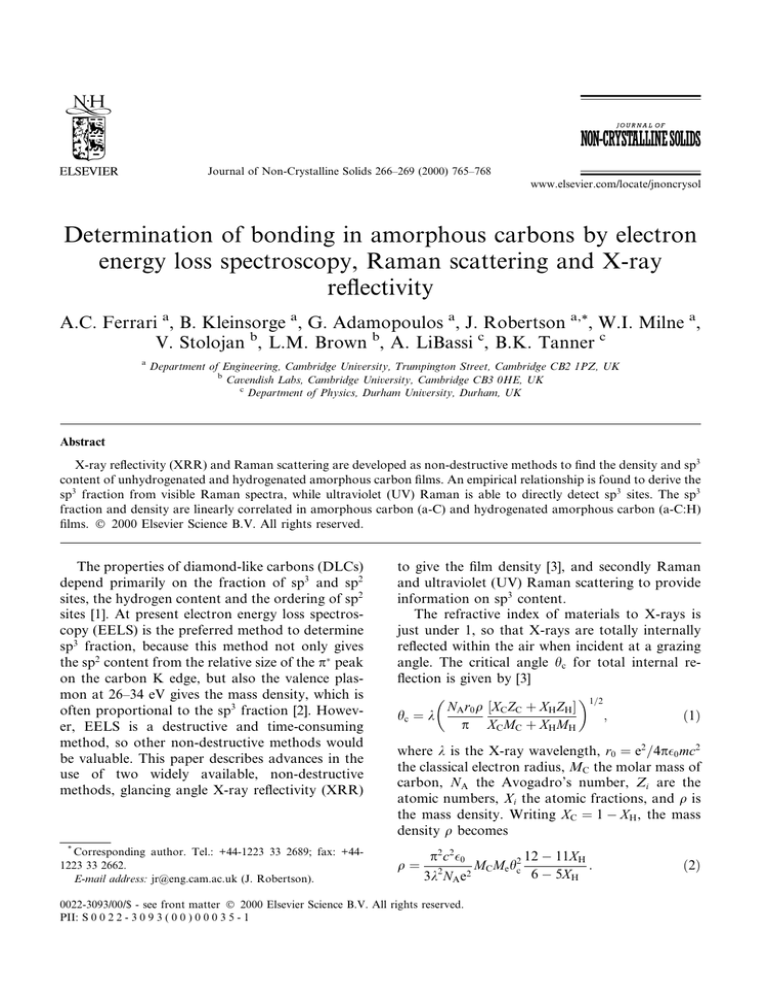
Journal of Non-Crystalline Solids 266±269 (2000) 765±768
www.elsevier.com/locate/jnoncrysol
Determination of bonding in amorphous carbons by electron
energy loss spectroscopy, Raman scattering and X-ray
re¯ectivity
A.C. Ferrari a, B. Kleinsorge a, G. Adamopoulos a, J. Robertson a,*, W.I. Milne a,
V. Stolojan b, L.M. Brown b, A. LiBassi c, B.K. Tanner c
a
Department of Engineering, Cambridge University, Trumpington Street, Cambridge CB2 1PZ, UK
b
Cavendish Labs, Cambridge University, Cambridge CB3 0HE, UK
c
Department of Physics, Durham University, Durham, UK
Abstract
X-ray re¯ectivity (XRR) and Raman scattering are developed as non-destructive methods to ®nd the density and sp3
content of unhydrogenated and hydrogenated amorphous carbon ®lms. An empirical relationship is found to derive the
sp3 fraction from visible Raman spectra, while ultraviolet (UV) Raman is able to directly detect sp3 sites. The sp3
fraction and density are linearly correlated in amorphous carbon (a-C) and hydrogenated amorphous carbon (a-C:H)
®lms. Ó 2000 Elsevier Science B.V. All rights reserved.
The properties of diamond-like carbons (DLCs)
depend primarily on the fraction of sp3 and sp2
sites, the hydrogen content and the ordering of sp2
sites [1]. At present electron energy loss spectroscopy (EELS) is the preferred method to determine
sp3 fraction, because this method not only gives
the sp2 content from the relative size of the p peak
on the carbon K edge, but also the valence plasmon at 26±34 eV gives the mass density, which is
often proportional to the sp3 fraction [2]. However, EELS is a destructive and time-consuming
method, so other non-destructive methods would
be valuable. This paper describes advances in the
use of two widely available, non-destructive
methods, glancing angle X-ray re¯ectivity (XRR)
*
Corresponding author. Tel.: +44-1223 33 2689; fax: +441223 33 2662.
E-mail address: jr@eng.cam.ac.uk (J. Robertson).
to give the ®lm density [3], and secondly Raman
and ultraviolet (UV) Raman scattering to provide
information on sp3 content.
The refractive index of materials to X-rays is
just under 1, so that X-rays are totally internally
re¯ected within the air when incident at a grazing
angle. The critical angle hc for total internal re¯ection is given by [3]
1=2
NA r0 q XC ZC XH ZH
;
1
hc k
p XC MC XH MH
where k is the X-ray wavelength, r0 e2 =4p0 mc2
the classical electron radius, MC the molar mass of
carbon, NA the Avogadro's number, Zi are the
atomic numbers, Xi the atomic fractions, and q is
the mass density. Writing XC 1 ÿ XH , the mass
density q becomes
q
p2 c2 0
12 ÿ 11XH
MC Me h2c
:
2
2
6 ÿ 5XH
3k NA e
0022-3093/00/$ - see front matter Ó 2000 Elsevier Science B.V. All rights reserved.
PII: S 0 0 2 2 - 3 0 9 3 ( 0 0 ) 0 0 0 3 5 - 1
2
766
A.C. Ferrari et al. / Journal of Non-Crystalline Solids 266±269 (2000) 765±768
Fig. 1 shows the re¯ected intensity from a tetrahedral amorphous carbon (ta-C) ®lm on a silicon
substrate. The re¯ected intensity drops sharply
above hc , and shows a series of oscillations as it
declines. For high density carbon ®lms such as taC, the main critical angle is due to the C ®lm.
However, lower density ®lms on Si such as a-C:H
have an electron density less than Si, so the main
hc is from the a-C:H/Si interface, and the a-C:H/air
interface gives a subsiduary critical angle at a
smaller angle. The intensity oscillations beyond hc
due to the interference between beams re¯ected
from the surface and substrate/®lm interface give
the ®lm thickness. The longer period oscillation is
due to internal layering. The complete information
on density, ®lm thickness, surface roughness and
the presence of internal layering is obtained by
modelling the re¯ections from the ®lm/substrate
pair. In this way, XRR can give the density and
thickness of carbon ®lms to high precision (0.05 g/
cm3 and 0.1 nm) [4].
The mass density was previously derived from
valence plasmon energy, Ep , measured by EELS
1=2
using Ep h
ne2 =e0 m or
Fig. 1. X-ray re¯ectivity vs scattering angle, for ta-C, ta-C:H
and a-C:H ®lms on Si substrates.
q
e0 MC m Ep2
2
12h NA
e2
!
12 ÿ 11XH
;
4 ÿ 3XH
3
where n is the valence electron density, m the
electron eective mass, e0 the permittivity of free
space and Ep is in eV. Comparing the derivation of
density from XRR and plasmon energies, Eqs. (2)
and (3), the X-ray critical angle is proportional to
the total number of electrons, whereas the plasmon energy is proportional to the valence electrons. Thus, XRR density is less sensitive to H
content than the plasmon energy, which is an advantage as H content is often less well known.
Eq. (3) assumes that valence electrons behave
like free electrons. This approximation works, but
it is necessary to use an electron eective mass m
of 0.85 to give the observed plasmon energy of
diamond (33.8 eV). It is unclear if the same m
holds for all carbons. Taking the mass densities of
various carbon ®lms found by XRR and plasmon
energies, we ®nd that m 0:87 gives a common ®t
to all plasmon energies, so this approximation
holds [4].
Fig. 2 shows the density derived by XRR and
from plasmon energies with this m value plotted
against sp3 fraction for ta-C deposited by a ®ltered
cathodic vacuum arc (FCVA) and ta-C:H deposited by plasma beam source (PBS) or by an electron cyclotron wave resonance (ECWR) system.
Fig. 2. Variation of density with sp3 fraction for ta-C ®lms
grown by FCVA and ta-C:H ®lms grown by PBS and ECWR.
Lines are guide to eye.
A.C. Ferrari et al. / Journal of Non-Crystalline Solids 266±269 (2000) 765±768
The density and sp3 content varies roughly linearly
for the two types of DLCs. The highest density for
ta-C is 3:26 0:05 g/cm3 for 88% sp3 fraction,
whereas the ta-C:H has a lower density of 2.36 g/
cm3 for 70% sp3 fraction.
The sp3 fraction is found from the carbon K
edge EELS spectrum. The sp2 fraction is derived
by taking the ratio of areas of the 285 eV peak due
to p states and 290 eV edge due to r states, and
comparing this to their ratio in graphite which is
100% sp2 [2].
Raman scattering using visible photons is a
popular method to probe the quality of CVD diamond and DLC. However, the visible Raman
spectra of DLCs is dominated by the sp2 sites,
which have a 55 times larger cross-section than
sp3 sites, because visible photons are only able to
excite p states. The Raman spectra of carbons is
dominated by two features, a G peak at around
1550 cmÿ1 and a D mode around 1350 cmÿ1 [5].
The G peak is derived from the zone centre E2g
bond stretching mode of graphite, and is present in
all sp2 bonded carbons. The D mode is a disorderactivated K zone boundary mode, due to the A1g
symmetry breathing motion of 6-fold aromatic
rings, which requires the presence of such rings.
The interesting feature of Raman in disordered
carbon is that the Raman spectra are dominated
by these two features, rather than resembling the
phonon density of states as it does in a-Si [6].
A detailed analysis of the variation of the Raman spectra of carbon on their bonding ®nds that
the spectra depend fundamentally on the ordering
of the sp2 sites [7]: whether sp2 sites form rings or
chains, the density of aromatic rings, and the size
of the aromatic ring clusters. If the sp3 and sp2
phases in DLCs are related, for example by the
deposition process, so that the ordering of the sp2
phase evolves as the sp3 fraction increases, then we
may use Raman spectra to derive sp3 content
empirically.
Fig. 3(a) shows the G peak wavenumber (measured at 514 nm) plotted against (Tauc) optical gap
for plasma deposited a-C:H from data of Tamor
and Vassell [8]. We previously found that the
optical gap of a-C:H varies systematically with sp3
content derived from EELS or NMR [9] (Fig. 4).
This variation allows us to plot G wavenumber
767
Fig. 3. G peak wavenumber vs: (a) optical (Tauc) gap and (b)
sp3 fraction, for as-deposited a-C:H ®lms (data from Tamor
and Vassell [8]) for excitation at 514 nm.
Fig. 4. Tauc gap vs sp2 content for various a-C and a-C:H ®lms
[9]. Lines are guide to eye.
768
A.C. Ferrari et al. / Journal of Non-Crystalline Solids 266±269 (2000) 765±768
Fig. 5. UV (244 nm) Raman spectra of ta-C, ta-C:H and a-C:H
and a visible Raman spectrum of a-C:H.
and ole®nic chains in diamond-like a-C:H, to
shorter ole®nic chains in polymeric a-C:H, and this
process causes the G peak to shift downwards.
The sp3 sites are not directly observed in visible
Raman. The higher photon energies of UV Raman
can excite the r states of sp3 sites. The UV Raman
spectra of ta-C shows a new broad peak at 1100
cmÿ1 labeled as T peak, attributed to sp3 sites [10]
(Fig. 5) The G peak is still present in UV Raman,
and has now moved to a higher wavenumber. It is
found that the ratio of areas of T to G peak correlates well with the sp3 content for ta-C [11]. The
UV Raman spectra of other DLCs such as ta-C:H
and a-C:H have been measured (Fig. 6). There is
now a much broader feature below the G peak
instead of a single T peak. There are a number of
contributions to this feature, including C±H
bending modes, which need to be further studied.
Thus, the ratio of T to G peak areas is a rough
guide to the sp3 content [12], but further work is
needed to provide a reliable relationship.
References
Fig. 6. Variation of UV Raman T to G peak area vs sp3
fraction for various carbon ®lms.
against sp3 content (Fig. 3(b)). It is seen that the G
peak decreases almost linearly with increasing sp3
content, and may saturate at the highest sp3 content. As the sp3 content increases in a-C:H, the sp2
site ordering changes from aromatic clusters at
large sp2 content, through single aromatic rings
[1] J. Robertson, Prog. Solid State Chem. 21 (1991) 199.
[2] P.J. Fallon, V.S. Veerasamy, C.A. Davis, J. Robertson,
G.A.J. Amaratunga, W.I. Milne, J. Koskinen, Phys. Rev.
B 48 (1993) 4777.
[3] F. Toney, S. Brennan, J. Appl. Phys. 66 (1989) 1861.
[4] A. Li Bassi, A.C. Ferrari, V. Stolojan, B.K. Tanner, J.
Robertson, L.M. Brown, Diamond Related Mater. (2000)
in press.
[5] R.J. Nemanich, S.A. Solin, Phys. Rev. B 20 (1979) 392.
[6] R. Alben, D. Weaire, J.E. Smith, M.H. Brodsky, Phys.
Rev. B 11 (1975) 2271.
[7] A.C. Ferrari, J. Robertson, Mater. Res. Soc. Symp. Proc.
593 (1999).
[8] M.A. Tamor, W.C. Vassell, J. Appl. Phys. 76 (1994) 3823.
[9] J. Robertson, Phys. Rev. B 53 (1996) 16302.
[10] K.W.R. Gilkes, H.S. Sands, D.N. Batchelder, J. Robertson, W.I. Milne, Appl. Phys. Lett. 70 (1997) 1980.
[11] S. Prawer, K.W. Nugent, in: S.R.P. Silva et al. (Eds.),
Amorphous Carbon State of Art, World Scienti®c, Singapore, 1998.
[12] G. Adamopoulos, K.W.R. Gilkes, J. Robertson, N.M.J.
Conway, B.Y. Kleinsorge, A. Buckley, D.N. Batchelder,
Diamond Related Mater. 8 (1999) 541.

